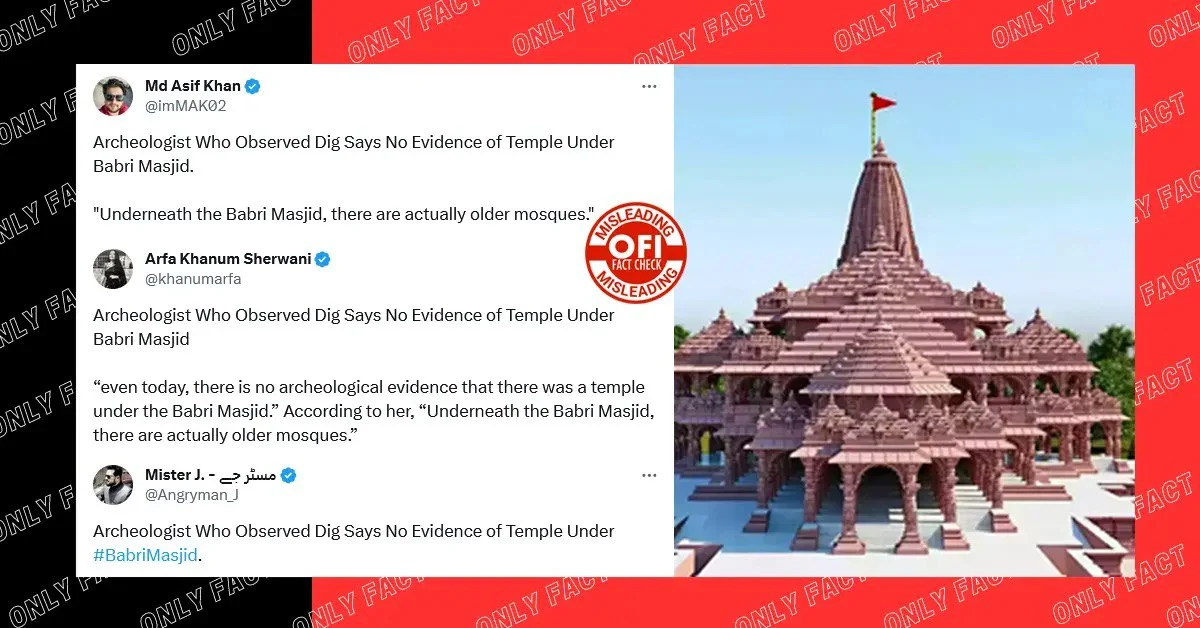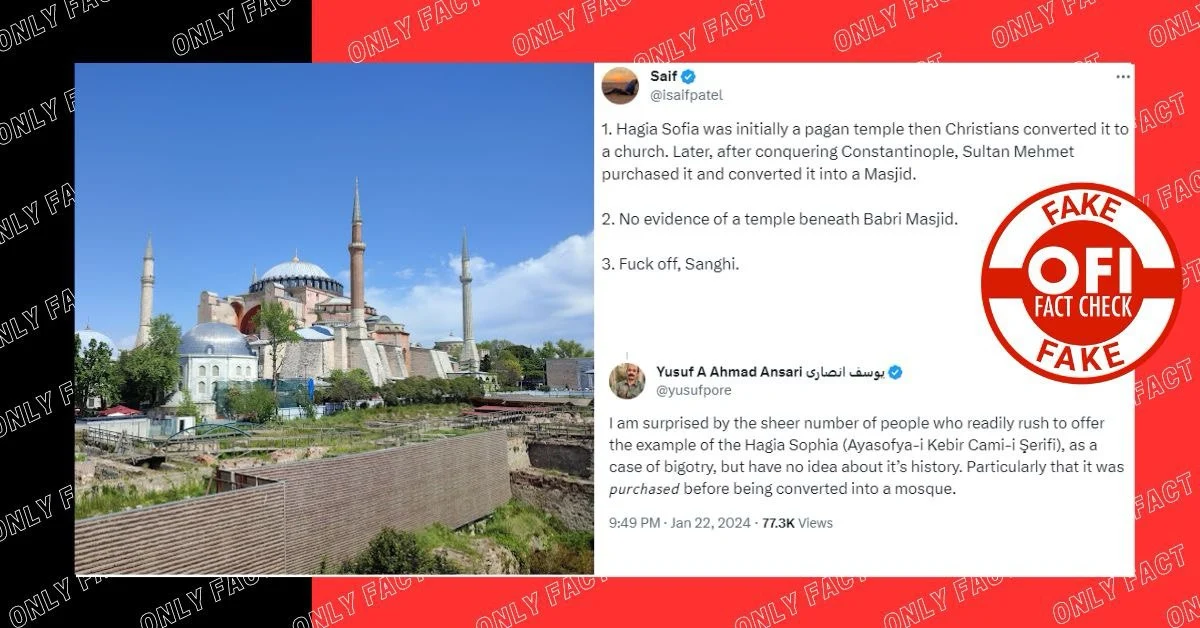The long-running Ram Temple and Babri Masjid dispute between both Hindu and Muslim religious sects over 2.77 acres of land in Uttar Pradesh’s Ayodhya came to an end in November 2019, when the court delivered its final verdict on the dispute. During the legal proceedings over the disputed land, the Supreme Court had ordered an archaeological investigation of the site where Hindus claimed that the Shri Ram temple was demolished to build a mosque, while the Muslim sect claimed that there was only a mosque at the place. However, when surveyed, ruins of the temple were found beneath the mosque and the final verdict was pronounced where the court gave the land to the Hindus.
After this the construction of the temple started in full swing. The temple will be constructed in three phases. The first phase has been completed and the Pran Pratishtha ceremony will take place on January 22 where the idol of Ram Lalla will be placed inside the temple and devotees will be allowed to enter inside the temple. However, amidst all this, the left wing propaganda portals are amplifying a fake narrative claiming that no temple was discovered beneath the mosque. The Wire published an article subtly promoting the narrative that there was no temple beneath the mosque, but rather the remains of older mosques were found. (Archived link of the article)
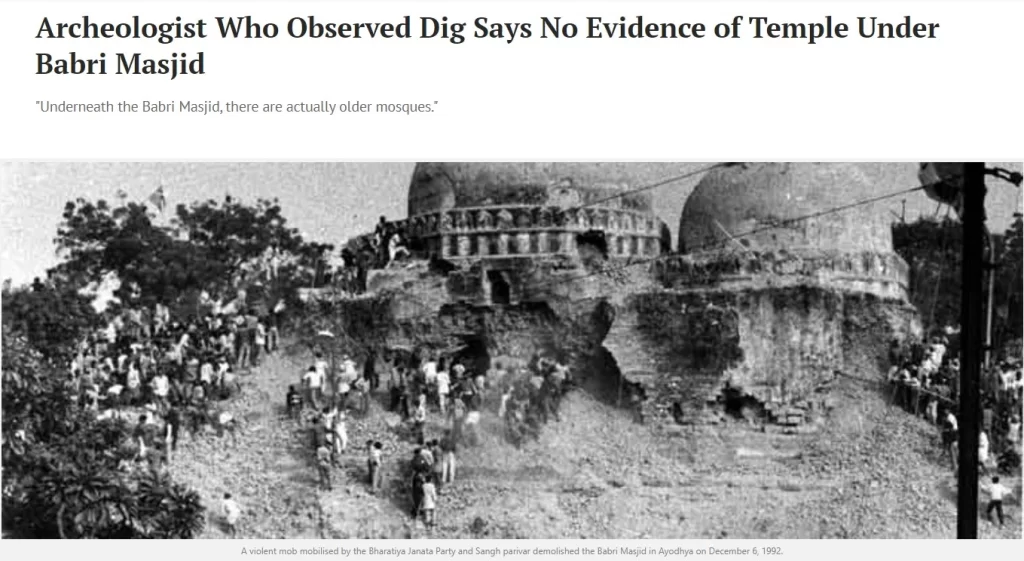
Also Read: The Claim About Shri Ram Temple Being Built 3 KM Away From Babri Mosque Site is FALSE
Fact Check
In our fact check research, we found a Supreme Court judgement report. The N9 section of the report discusses the findings of the archeological survey.
The Archaeological Survey of India (ASI) in its final discovery concluded that another structure existed beneath the Babri mosque. The report said the structure in dispute was built directly on top of another construction. Evidence of a massive and monumental structure with minimum dimensions of 50×30 meters in both north-south and east-west directions was found. In the Excavation findings, researchers had found nearly 50 pillar bases with a foundation made of brick bat. These pillars support calcrete blocks, which are in turn topped by sandstone blocks. These findings provide evidence of the existence of the earlier massive structure.
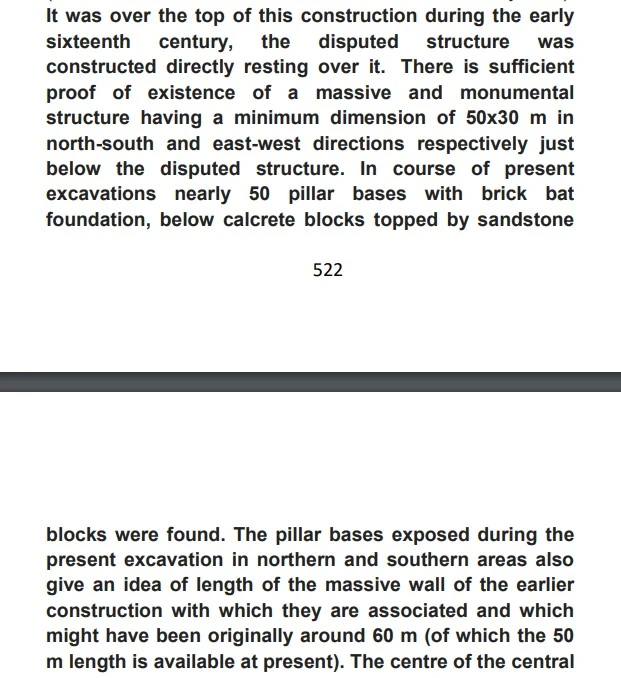
The report further said that in the ASI survey various stone artefacts, decorated bricks, sculptures of divine figures and carved architectural elements such as door frames and pillars were found. These discoveries are similar to typical features found in temples throughout North India, suggesting a historical and cultural connection.
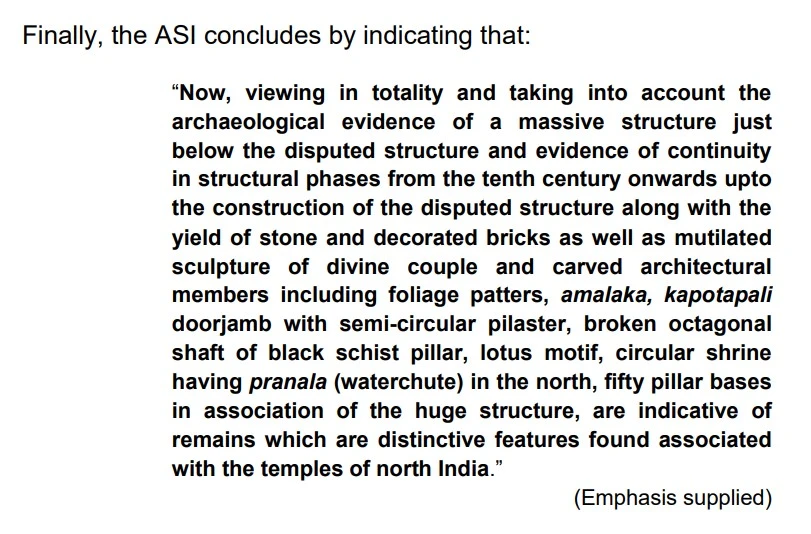
Furthermore, reports indicates that in the post-Gupta period, significant structural activity was observed at this site. This activity revealed the existence of a circular brick temple with a circular exterior with an entrance from the east. The ASI has concluded that the northern wall of the temple has a pranala, i.e. a water chute, which it considers to be a typical feature of temples in the plains of the Ganga and Yamuna.
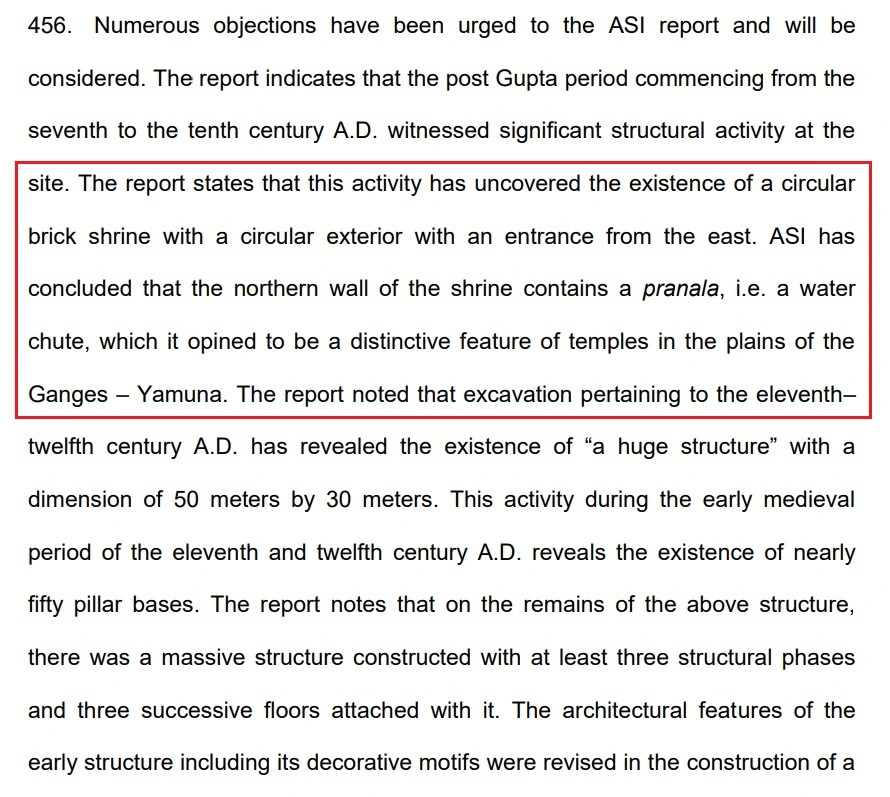
The judgment of the Supreme Court of India on the Ram Janmabhoomi case heavily relies on the archaeological findings conducted by the Archaeological Survey of India (ASI). Key discoveries, such as terracotta figurines depicting female deities and a round signet inscribed with the legend of Asoka Brahmi, dating back to circa 1000 BC to 300 BC, played a crucial role in establishing the historical context.
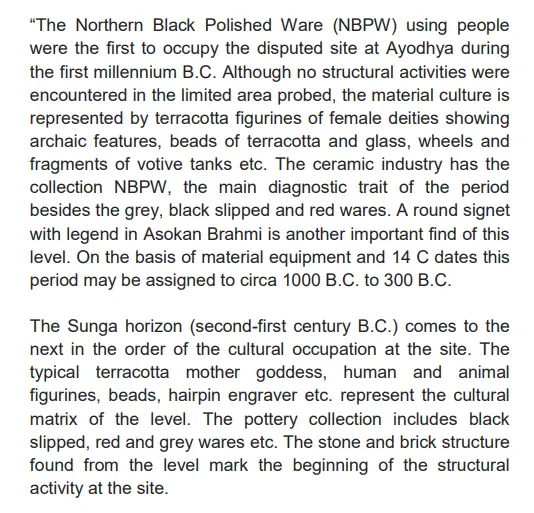
The excavation revealed significant evidence from various periods, including the Shunga Period (first and second century BC), marked by terracotta mother goddesses, human and animal figurines, as well as pottery and stone and brick structures. The subsequent Kushan period (first to third century A.D.) showcased terracotta human and animal figurines, votive tanks, beads, antimony rod, and large-sized structures spanning twenty-two courses.

Moving into the Post-Gupta-Rajput period (seventh to tenth century A.D.), the site continued to witness structural development, primarily constructed with burnt bricks. Notably, a circular brick shrine emerged during this period, shedding light on its functional significance for the first time.
Transitioning to the early medieval period (eleventh to twelfth century A.D.), a substantial structure with a north-south orientation was constructed, albeit short-lived, as only four of the fifty pillar bases exposed during excavation belonged to this level, featuring a brick crush floor.
Examining the historical pattern evident in ASI excavations, a consistent timeline emerges, ranging from 1000 BC through the Shunga, Kushan, Gupta, Rajput, and medieval periods. The findings encompass figurines, deities, pottery, and stone artifacts, collectively affirming the existence of a temple and its evolutionary contributions across diverse historical epochs.
The report mentions that the pre-existing structure beneath the Babri mosque dates back to the 12th century. The foundation of the mosque is based on the walls of a large pre-existing structure. The characteristics and architectural features of the underlying structure are suggestive of a Hindu religious origin comparable to temple excavations in the region and pertaining to the era.
KK Muhammed accepted the existence of temple under mosque
KK Muhammad was part of the team that first excavation that took place at the site in 1976–77. In a podcast interview with Ranveer Allahbadia, archaeologist K.K Muhammad shared insights into the excavation of the Ram Janambhumi site. During the interview, Muhammad, who participated in the 1976-77 excavations in Ayodhya under the direction of Prof. B.B Lal, a renowned excavator, highlighted the meticulous process involved in contextualizing the site.
Muhammad explained that prior to excavation, they conducted explorations to understand the site’s context. During this phase, they observed that the pillars supporting the mosque were, in fact, components of the temple’s pillars. To distinguish between temple and mosque pillars, the team employed a method known as stylistic dating, which involves analyzing the aging and periods of infrastructure.
Detailing the excavation process, Muhammad noted that they focused on the rear side of the mosque, specifically in the western and southern areas. In these locations, they discovered pillar bases and a significant number of terracotta idols, providing compelling evidence of a pre-existing temple beneath the mosque. Muhammad concluded that their findings strongly indicated the presence of a temple at the site, with the mosque subsequently constructed after the temple was dismantled.
Pictures of structures found in excavation
Dainik Bhaskar in one of its recent report, shared the pictures of the structures that were discovered in the ASI survey 21 years ago i.e. in 2002. The number of remains is around 50. These include 8 broken pillars, 6 fragmented statues, 5-6 earthen pots and 6-7 urns. On the rocks found sculptures of gods and goddesses are carved.
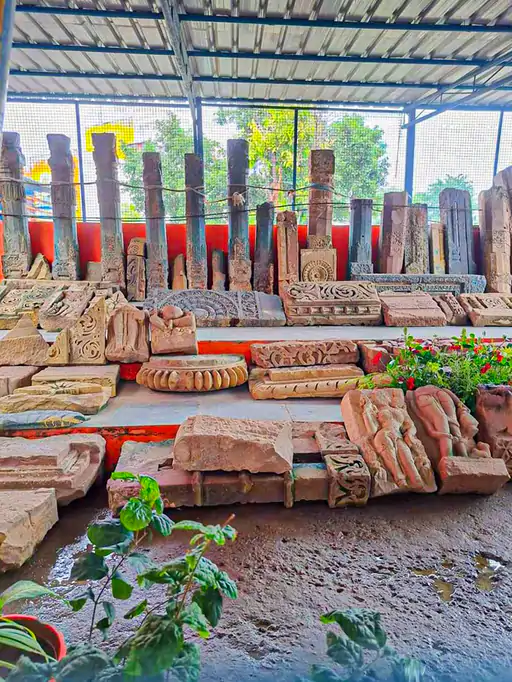
The pillars had Kalash inscribed on them
The Times Now Bharat have accessed the pictures from the 1990 survey of the disputed site. Pictures show that the pillars which were reused in the construction of the temple are marked with Kalash. Kalash is a copper vessel with a wide base and small mouth that is an important symbol in Hinduism. It is also known as Purna Kalash, Purna-Kumbh and Purna Ghat.
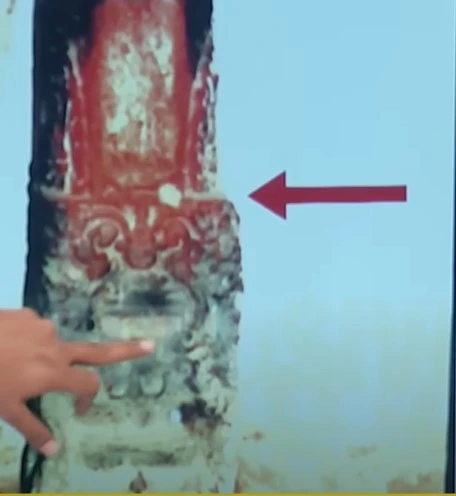
In a recent episode of the “News Ke Pathshala” show on Times Now, archaeologist KK Muhammad was featured as a guest. During the show, journalist Sushant Sinha presented images from inside the Babri temple, focusing on the 12 pillars that formed the foundation of the controversial site. Sinha highlighted the images of these pillars, revealing Hindu inscriptions and intricate Hindu designs carved into the stone. The visual evidence strongly suggested that the mosque had been constructed atop pillars that originally belonged to a Hindu temple, providing clear indications of the pre-existing structure that had been dismantled before the mosque was erected.
Furthermore, KK Muhammad, while speaking to Times Now Bharat, said that the kalash inscribed on the pillars are purna-kalash. It is an auspicious symbol in Hinduism and these Purna-kalash were found in temples in the 12th century. He also revealed that during the excavations, the structures were found with gods and goddesses carved on them. Many other structures were found which were associated with the Hindu religion.
Conclusion: The Wire article’s claim is false. The remains of the old mosque were not found, but the remains found below the temple have architectural features of Hinduism.
| Claim | The existence of a temple was not found under Babri Masjid, but ruins of old mosques were found. |
| Claimed by | The Wire |
| Fact Check | False |

